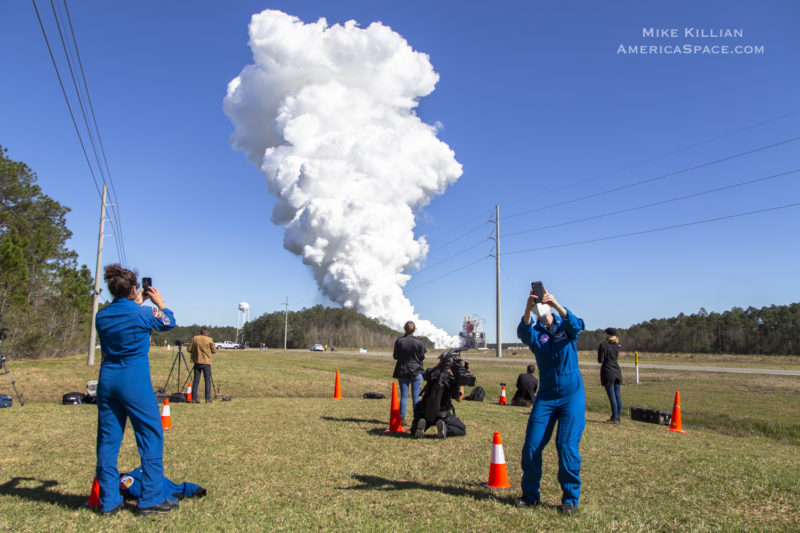
With a thunderous roar, four ex-Space Shuttle Main Engines (SSMEs) which will soon help propel the world’s most powerful rocket came spectacularly to life for eight beautiful minutes Thursday afternoon, in a second critical Hot Fire Test of the first Space Launch System (SLS) Core Stage. The four engines, which saw extensive refurbishment after 1.1 million seconds’ worth of “burn-time” on a combined 25 shuttle flights, ignited as planned within a few hundredths of a second of each other at 4:37 p.m. EDT on the historic B-2 Test Stand at NASA’s Stennis Space Center (SSC) in Bay St. Louis, Miss.
Producing more than 1.6 million pounds (725,000 kg) of thrust, the engines burned for eight minutes and 19.6 seconds (a total of 499.6 seconds), closely mirroring a full flight-duration firing and moving the Core Stage one step closer to its Artemis-1 maiden voyage, which remains targeted to launch, according to NASA, “later this year”.
This afternoon marked the second Hot Fire Test of the Core Stage, following a shorter-than-anticipated first attempt on 16 January. And for the 212-foot-tall (64.6-meter) Core Stage, it comes after more than a year spent ensconced in the B-2 Test Stand. Following its delivery from NASA’s Michoud Assembly Facility (MAF) in New Orleans, La., aboard the Pegasus barge in the second week of January 2020, the Boeing-built core was hoisted into the cavernous expanse of the test stand.
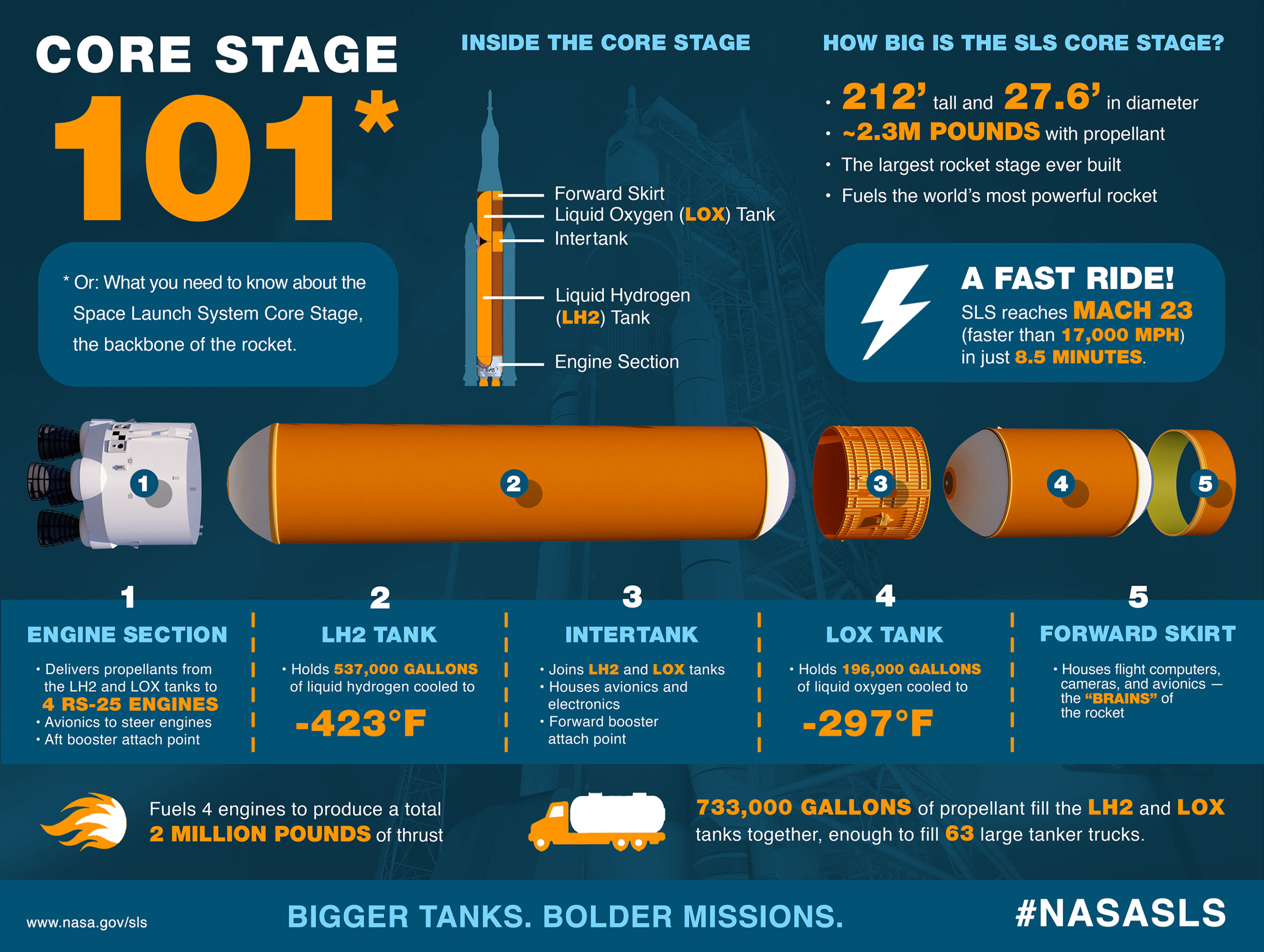
Over the next nine months, through last September, it was put through a punishing regime of five “functional” Green Run tests. These validated models to operate its Guidance, Navigation and Control (GNC) systems, checked out its avionics, tested its safety systems, evaluated command and control capabilities for its Main Propulsion System (MPS) and operated its Thrust Vector Control (TVC) and hydraulics.
These five functional tests were accomplished with remarkable pace and agility on the part of the tight-knit NASA/Boeing team, particularly in light of the worldwide march of the COVID-19 coronavirus pandemic and the ravages of multiple natural predators in the form of Hurricanes Marco, Laura and Sally last summer and Hurricane Zeta last fall.
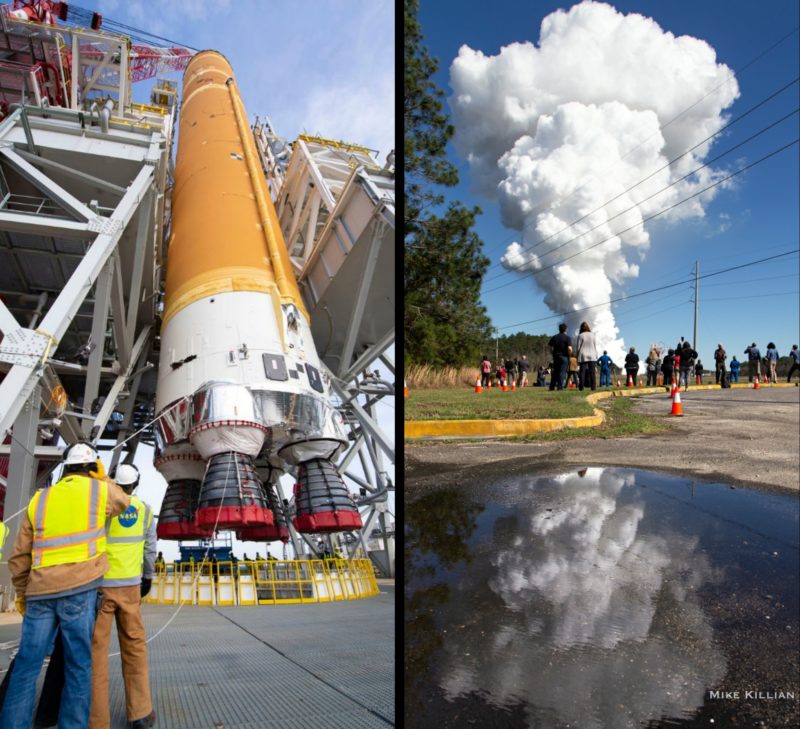
In the wake of the functional tests, three “operational” Green Run tests got underway in October, which were designed to simulate a full SLS countdown, loading more than 733,000 gallons (3.3 million liters) of cryogenic oxygen and hydrogen propellants into the Core Stage—known as the Wet Dress Rehearsal (WDR)—and firing the four RS-25 engines for a full mission duration of eight minutes. This “Hot Fire Test” got underway on 16 January, but was cut short and the engines commanded to shut down after only 67.2 seconds.
The premature shutdown was triggered when one engine exceeded its highly conservative test parameters. Original plans called for the quartet of engines to be fired for up to 485 seconds, approximating as closely as possible the conditions that they will encounter during the SLS rocket’s raging climb to orbit. But one of the four Core Auxiliary Power Units (CAPUs) detected low hydraulic fluid levels and after a series of verification checks, properly shut itself down. The Core Stage flight computer responded by commanding the remaining engines to shut down in a process which proceeded smoothly and safely.
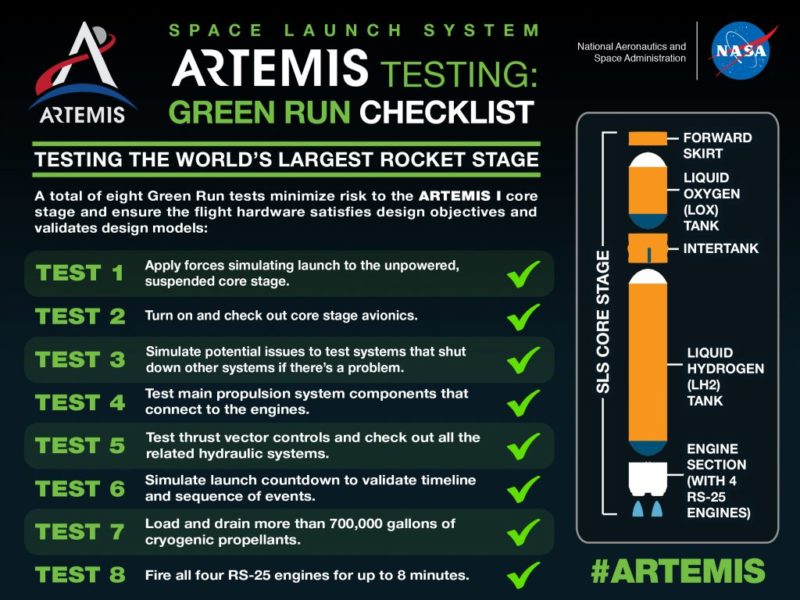
Notwithstanding the disappointment on 16 January, five significant successes were achieved. These included the critical transition to the automated launch sequence (operated by the Core Stage flight computer and Green Run software), completing the terminal countdown sequence, pressurizing the propellant tanks, firing the four engines at a 109-percent power level and operating the TVC for effective steering capability.
Late in January, NASA and Boeing announced their intent to conduct a second Hot Fire Test “as early as the fourth week in February”, revealing that doing so “would pose minimal risk” to the hardware, whilst yielding valuable certification data ahead of Artemis-1. This eventually firmed-up with a 25 February target date for the Hot Fire Test and an expectation that the powering-up of the core’s computers and avionics would get underway a couple of days prior. But on 22 February, NASA reported that it was investigating the performance of one of eight critical prevalves on one of the RS-25 engines, which did not appear to be functioning as it should.
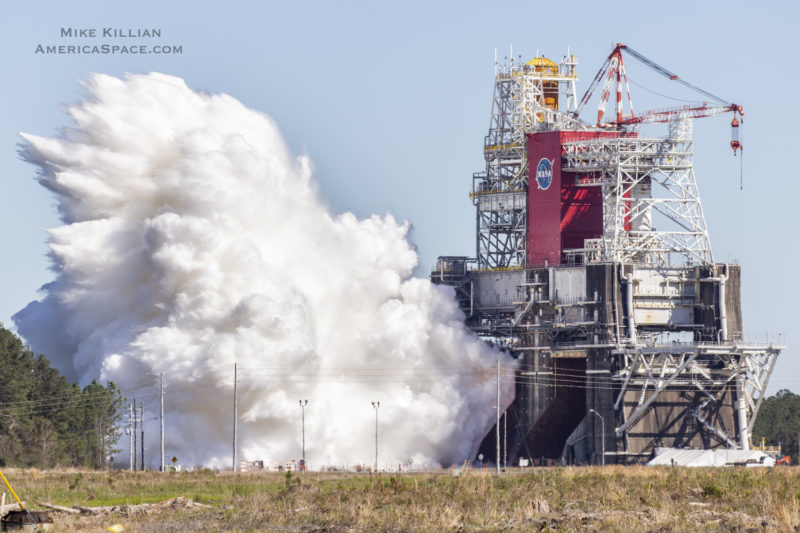
Technicians accessed the troublesome valve via work platforms inside the B-2 Test Stand and it was repaired over the weekend of 27/28 February. Last week, NASA announced a revised date of 18 March for the second Hot Fire Test.
In readiness for the today’s milestone activity, the Core Stage’s flight computers and avionics were brought online on Tuesday. And early this morning, the test team performed a pre-test briefing in the Test Control Center at the B Test Complex, which yielded a unanimous “Go” to commence fueling the core with 733,000 gallons (3.3 million liters) of liquid oxygen and hydrogen. Following the completion of this task—with the liquid oxygen cooled to -182 degree Celsius (-297 degrees Fahrenheit) and the liquid hydrogen to -252 degrees Celsius (-423 degrees Fahrenheit)—the Test Conductor polled the team for their final “Go/No-Go” status.
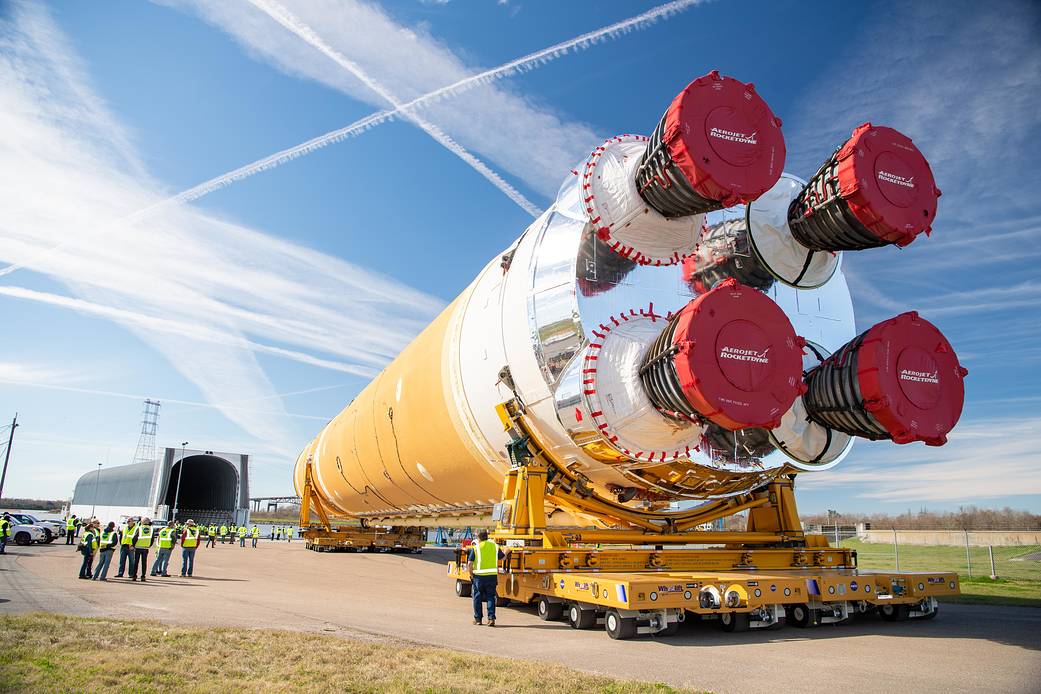
With this step thus passed, the Terminal Countdown commenced crisply at 4:27:12 p.m. EDT, at which point the final ten minutes of the countdown got underway. At six minutes, the securing of the Core Stage’s liquid hydrogen tanks got underway, with liquid oxygen securing at T-4 minutes. This was followed at 90 seconds before Engine Start by the transition of the Core Stage to internal power. The Water Deluge System was activated and went “full-bore”, delivering 240,000 gallons (1.1 million liters) of water per minute into the base of the test stand to reduce the reflected energy, vibration and sound.
At T-30 seconds, the test team initiated the autonomous launch sequencer as the Core Stage transitioned from ground command to on-board software control. And at 12 seconds, the burnoff igniters—like a shower of sparklers—were fired to dissipate unburnt hydrogen lingering underneath the engine bells of the four RS-25s. In a fashion not dissimilar to the old Space Shuttle days, the ignition sequence was staggered, as Engines One, Three, Four and finally Two came alive at intervals of a few hundredths of a second at around T-6.6 seconds. They quickly ramped up to full power, generating a quartet of “Mach diamonds”, as their almost-colorless exhaust gases exited the nozzles at 13 times the speed of sound.
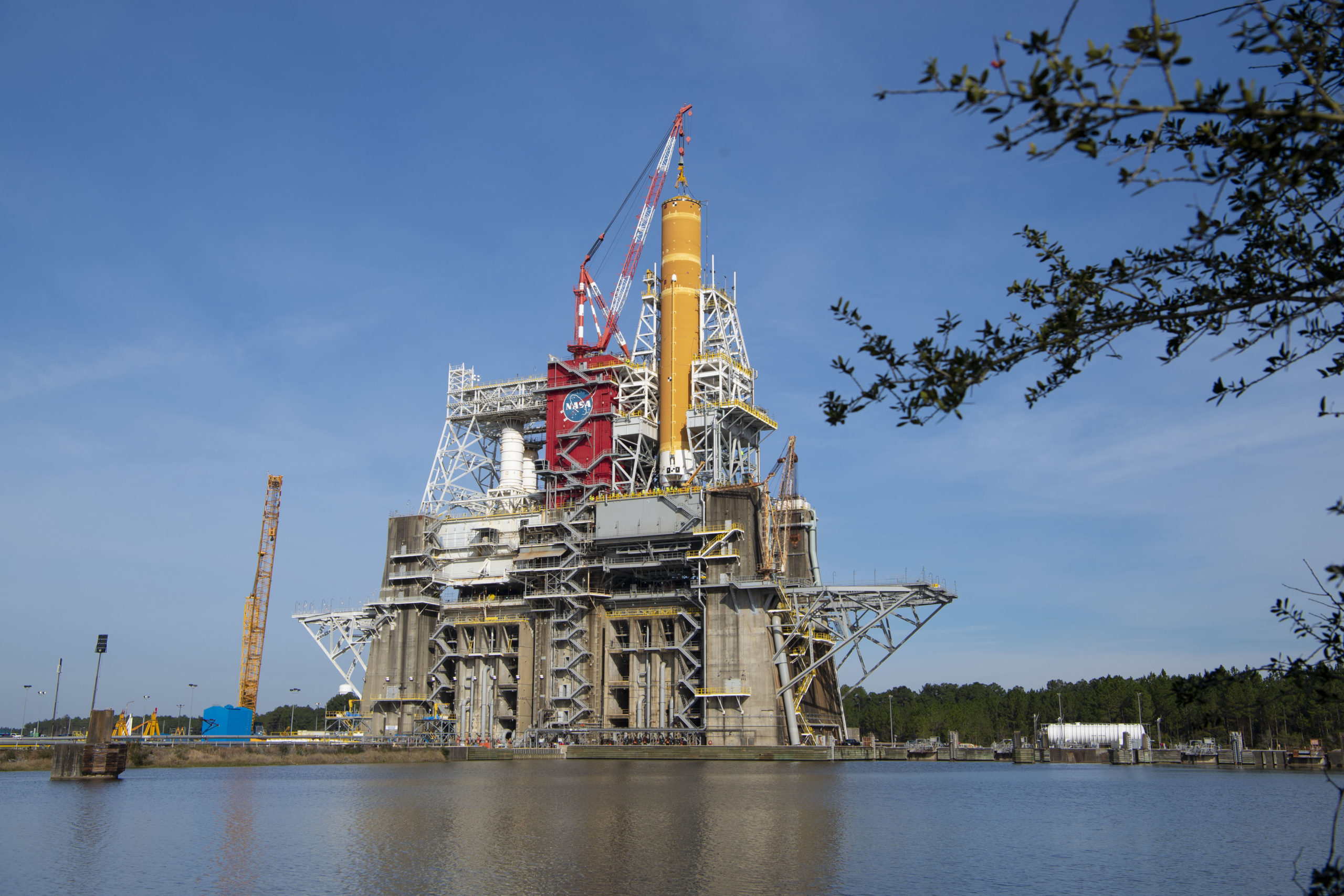
There, however, the similarities ended. Whereas the shuttle-era RS-25s burned to a maximum power level of 104.5 percent of rated performance, those of the SLS Core Stage will typically ramp up to 109 percent at liftoff. At T-2 seconds, the Stage Controller issued a “Go for Test” as the countdown moved from the Pre-Count to the Plus-Count.
“All personnel, we’ve got Engine Start” came the call from the test team as the Plus-Count got underway at 4:37 p.m. EDT. A minute into the burn, more than a heart or two undoubtedly skipped a beat, as many minds were cast back to the final seconds of 16 January’s bittersweet test. But the burn continued smoothly and with apparent perfection. The Thrust Vector Control (TVC) profile commenced shortly thereafter, as all four RS-25s were commanded through a pre-programmed gimbaling exercise. Another TVC gimbal was conducted later in the test, at about T+7 minutes and 30 seconds.
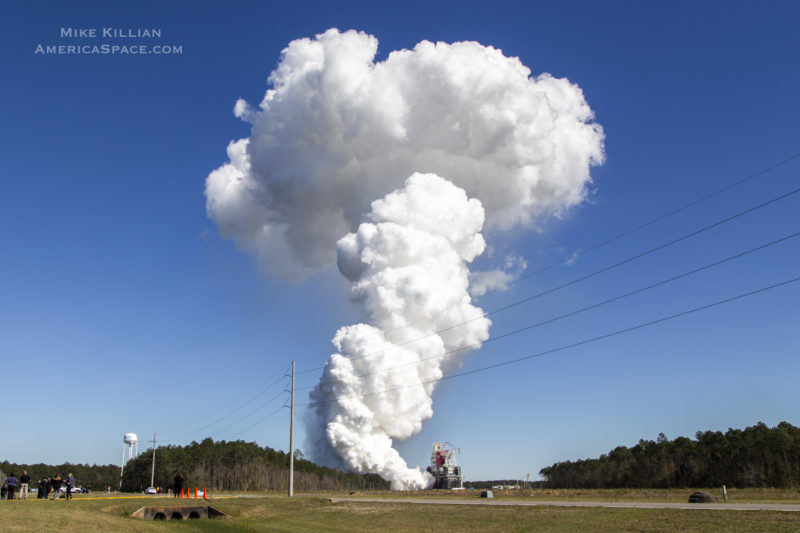
Cutoff, when it came at 4:45 p.m. EDT, was met with both an ethereal silence and a cacophony of applause from the test team. Preliminary data-gathering will consume the coming days and perhaps weeks, but in reaching a full flight duration the Core Stage has undoubtedly cleared a significant hurdle on the road to launch.
On hand this afternoon were NASA astronaut Zena Cardman and “Artemis Team” members Woody Hoburg and Jessica Meir. “Congrats @NASA teams,” tweeted Meir. “Mission accomplished with today’s @NASAArtemis #GreenRun.”
“Safe engine shutdown,” came the call, as the engines entered post-shutdown standby. And in spite of some observed burning at the aft end of the stage, there were no Test Commit Criteria (TCC) violations recorded. Many had anticipated Artemis-1 to move to the spring of 2022 at the soonest, but both before and after today’s test NASA revealed that it was still targeting Artemis-1 for later this year. Stacking of the twin, five-segment Solid Rocket Boosters (SRBs) at the Kennedy Space Center (KSC) in Florida was completed earlier in March, with the Core Stage expected to be delivered to the Cape later this spring.
.
.
FOLLOW AmericaSpace on Facebook and Twitter!
.
.
Missions » SLS » Artemis »



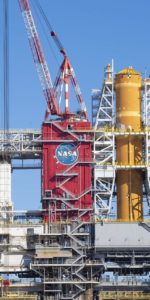
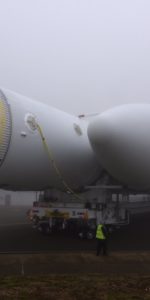
Ooh yeah this Was a fine test congrats eve
ryone
great work .
was this a full throttel-wide open ? or was there pre-set group of variations programed to put the engine through its paces ?
can’t wait
anyway
thamks for the rush
cu
Great test and great milestone for the SLS program! Onto KSC!